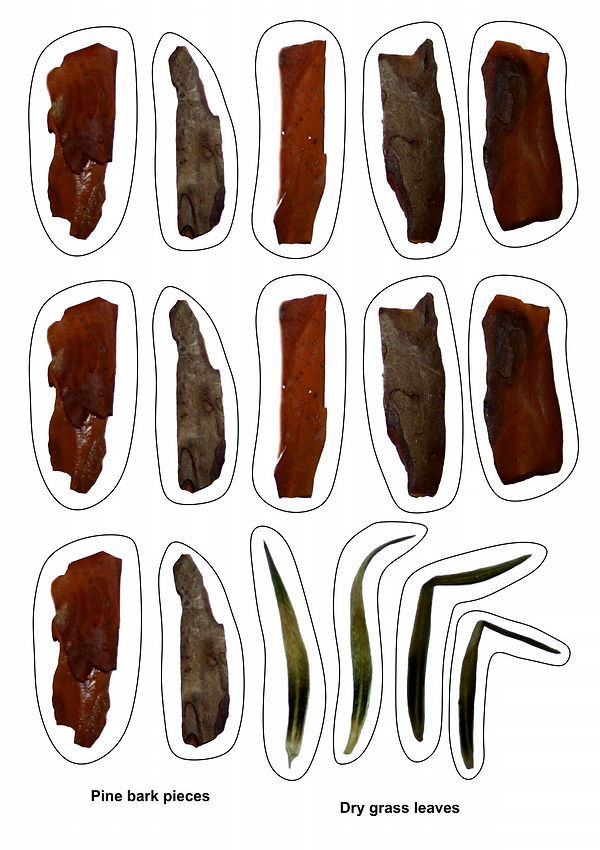


Communication on a Forest Language
Copyright Certificate of Registration TXu 2-038-550
Library of Congress, Washington D.C., Jan 14, 2017
Year of Completion - 2015
Game set:
-
15 Sets of “Materials” of Forest Language
-
15 Iron Circles - 7,8 inches in diameter
Age: from 10
INTRODUCTION
Before the 20th century, native people of the North-East Asia (Evenks, Nanai) had the specific forest language to communicate to each other in taiga forest. They had been writing messages on trees without any letters and words. These messages were made from different particles of plants and animals, which had been set together on a tree on humans’ eye level with using the pine tree pitch.
Native people almost forgot this language now. People from Europe, who live in the Russian Far East mostly from the middle of the 19th century, know just a little about the aboriginal peoples’ communication in the Russian Far East taiga. However, this language reflects not only regional history details, but also relationships of these people and nature, their perception and understanding of nature laws.
Results of collecting ethnographic knowledge from native people of the North-East Asia showed that this is a way for people to communicate to each other in unusual way nowadays. In this game, some meanings of this language from native people and significant addictions are represented.
Activity “Communication on a Forest Language” The essence of this communication is in messages, which people, who are going on a trail, leaving to each other to tell a short story about themselves in this particular place. Message is a composition from the different particles of plants and animals, and every detail and character of its placing means something, like in Japanese ikebana. Collected and developed set of meanings, which consist modern forest language, is represented below.
Forest Language Meanings
-
Pine needles – after how many days they will come back on this place if they will do so;
-
Dry small branches – how many people are in the group
-
Single bird feather – they go hunting
-
Few different feathers of birds – Please be quiet, birds’ nesting area
-
Berry or berry bush leave – they go to stock up berries
-
Piece of mushroom – they go to get some mushrooms
-
Piece of lichen – they know this area very good, they’ve been here several times;
-
Umbrella-shape flower – they have a telephone connection
-
Leave of a familiar medicine plant – they go to stock up medicine plants
-
Dry small branch with “fork” – people who leaved this message are lost
-
Dry small branch with “fork” crossed with straight piece of branch – they try to find somebody who had been lost
-
Oak acorn – Beware of the wild boar
-
Pine acorn – Area of regular seasonal fires
-
Nut – Beware of the bear
-
Curved branch – Beware of poison snakes around
-
Birch bark stripes – days (date of the message)
-
Small pieces of pine bark – months (date of the message)
-
Dry grass leaves – people who leaved this message, had a serious problem with finding water within the area
-
Dry grass leaves with one broken side – Be aware of dirty water in a nearest stream or lake
-
Piece of the tree mushroom – please leave your message nearby
Before the game, teacher gives Meaning Sheet and set of “materials” (given below) that must be printed on magnetic paper, to each player, or small group of players. Players also take iron circles that will be a base for the message. Each person or group can choose their own few meanings and particles to build a message according to their created legend. It can be, for example, pine-needle and five other components. Then all groups or individual participants are going to different directions at the forest area. They must choose relatively visible places and begin to create their messages. Message must be compact and placed on the ground being visible from the trail. If this game will be organized indoor, messages would be simply placed on tables. The beautiful and reasonable combination of the details between each other is preferable.
When this creative work is finished, players must point out their places with messages, and from this moment they can begin to communicate on the forest language! They walk in the area, finding different messages of each other and trying to read it using Meanings Sheet.
Teacher can discuss messages with participants and note the best (most beautiful and clear messages). Players can also take pictures with their messages and themselves, and then collect photos to the album, where pictures can be added by those messages’ translations.
Finally, organizing this game gives an opportunity to develop excellent skills of observation among players, which also is very important in nature observation and understanding.
Forest Language Set







Game Photo Gallery
 |  |  |
|---|